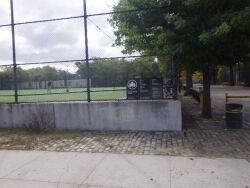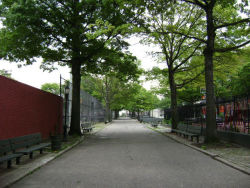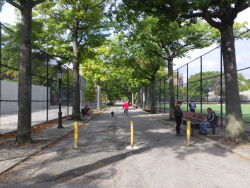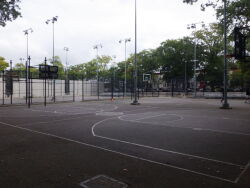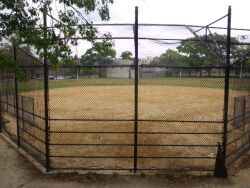St. John's Park
St. John’s Recreation Center
What was here before?
In the 18th century this land was split between the holdings of Jeremiah Remsen and the heirs of Samuel Gerritsen. Remsen’s land later passed through a succession of descendants.
By the late 1940s, this site was lined with several multi-story residential and commercial buildings, as well as Engine Company 234. In 1950, hundreds of residents in these buildings were displaced in preparation for the construction of the New York City Housing Authority’s 800-unit Albany Houses complex and an accompanying park. The buildings, including Engine Company 234, were demolished. The firehouse later moved to a new facility a few blocks south on St. John’s Place. Former residents of the buildings on this site were later offered apartments in the Albany Houses which opened in 1953.
How did this facility become a recreation center?
The buildings that were on this site were acquired by the City in 1950. Plans were made shortly thereafter to eliminate the stretch of St. Mark’s Place that ran between Schenectady and Troy Avenues to create more parkland with the intention of eventually building a recreation center at the site.
Parks Commissioner Robert Moses (1888-1981), answering critics of the project in a 1953 letter to the Board of Estimate, viewed a new generation of recreation centers as a way to provide positive outlets for children in disadvantaged communities.
The first phase of Moses’s vision for the park, its outdoor component, included three softball fields and a public restroom opened in 1953. Outdoor basketball and handball facilities were added in 1955. The recreation center was completed in 1956, becoming the third such type of indoor facility to open in the city.
Moses’s belief in the power of urban planning to improve social conditions, especially through recreation, was the impetus behind the creation of the centers citywide. “The opening of this building will enable the Department of Parks to establish a well-rounded recreation program in the heavily populated Bedford-Stuyvesant section of Brooklyn where such a program is urgently needed,” Moses wrote when the facility opened. Pointing to the center’s gymnasium, its 42-foot by 75-foot swimming pool, and its woodwork, “domestic science,” exercise, and boxing facilities.
The park was renovated in 1987, which included improvements to the recreation center’s interior. Later upgrades included the addition of an exterior restroom building in 2018, and the construction of an outdoor adult fitness area in 2022. The recreation center features an indoor pool, media lab, indoor basketball courts, a gymnasium, a weight room, and multiple rooms for fitness classes and games.
Who is this recreation center named for?
St. John the Apostle is the patron saint of love, loyalty, friendship, and authors. The recreation center and surrounding park share a name with St. John’s Place, a street three blocks south of the park, and the former St. John’s Orphan Asylum for Boys, which occupied a full city block across Troy Avenue. The orphanage opened in 1868, and despite suffering a deadly fire in 1884, operated until 1948. This block and the adjoining two blocks to the north were razed and replaced by the Albany Houses complex.
Check out your park's Vital Signs
Clean & Safe
Green & Resilient
Empowered & Engaged Users
Share your feedback or learn more about how this park is part of a
Vital Park System

